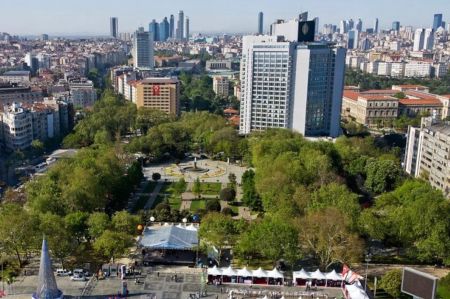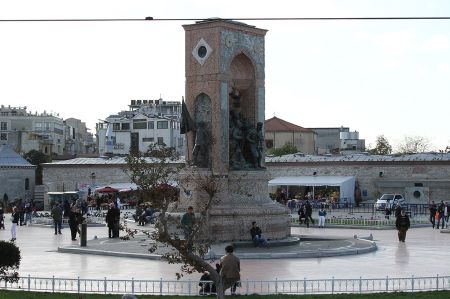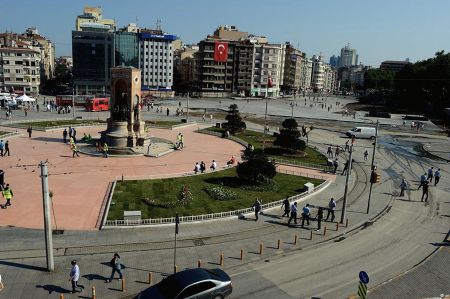On everyone's lips – Istanbul's Gezi Park
- Written by Portal Editor
A small, almost insignificant park in Istanbul has made the headlines of the world press in recent weeks and there is currently no end in sight.
After the occupations by demonstrators with the associated construction of a tent city, the park has been cleared several times under massive police action and has now been freshly decorated with flowers and trees, as if nothing had happened. Does the park itself have any political significance or relevance?
On a section of today's park area there was an Armenian cemetery for almost 400 years until 1930, which became less and less important after the genocide of the Armenians in 1915. Almost the entire Armenian population had been murdered or expelled by the time of the Ottoman Empire, and an Armenian cemetery was no longer needed. In the years that followed, further destruction occurred, marble tombstones were sold or used in other construction projects, including the later construction of Gezi Park. But one after anonther.
Areas of around 30 hectares that had become free were to form the base area for a public park
 Under President Atatürk, who wanted to create a modern Turkey based on the Western model, architects and planners were brought to the country in addition to many political and scientific experts, including the French architect and urban planner Henri Prost. In addition to parts of Taksim Square, the area around today's Gezi Park was also to be redesigned. Prost began replanning the site in 1936, which included the demolition of the 1806 Topçu Barracks that existed there at the time. The then governor and mayor of Istanbul, Mr. Lüfti Kırdar, subsequently ordered the demolition of the Topçu barracks and the existing Taksim Stadium, based on Prost's plans. The area of approx. 30 hectares that had been freed up was to form the base area for a public park, which was planned and implemented by Prost. Today there is no consensus as to whether the park was completed in 1947 or only in 1951. In any case, the park was named "Inönü Park" in honor of the second president of the republic, Ismet Inönü.
Under President Atatürk, who wanted to create a modern Turkey based on the Western model, architects and planners were brought to the country in addition to many political and scientific experts, including the French architect and urban planner Henri Prost. In addition to parts of Taksim Square, the area around today's Gezi Park was also to be redesigned. Prost began replanning the site in 1936, which included the demolition of the 1806 Topçu Barracks that existed there at the time. The then governor and mayor of Istanbul, Mr. Lüfti Kırdar, subsequently ordered the demolition of the Topçu barracks and the existing Taksim Stadium, based on Prost's plans. The area of approx. 30 hectares that had been freed up was to form the base area for a public park, which was planned and implemented by Prost. Today there is no consensus as to whether the park was completed in 1947 or only in 1951. In any case, the park was named "Inönü Park" in honor of the second president of the republic, Ismet Inönü.
In the following years, the parking area was greatly reduced by the construction of hotels, including the Marmara Hotel. Important for the local population of the Beyoğlu district, the Rest Park remained as a local recreation center and was always heavily frequented. This is probably how the name Gezi Park, which is so famous today, came about, which means something like “walk”. Hardly anyone knows the actual name of the park. In addition to a fountain in a roundabout and some large trees that are around 70 years old, there are only a few park benches. So nothing special in Moloch Istanbul – and yet so important?
When the city administration of Beyoğlu decided to partially remove the park in September 2011, there were some immediate protests from citizens and city planners against the removal of this local recreation area and the felling of the trees in the park, but nobody took these thoughts seriously. When the Turkish government decided in May 2013, after several other random large-scale projects, to have a shopping center built here with a faithful replica of the façade of the Topcu barracks, a protest movement quickly developed that was no longer solely focused on the construction project in Gezi Park limited. On May 28, 2013, a new era began in Turkey with the start of the wave of protests. Responsible citizens want to be involved in major projects, they want a say in projects that affect their immediate surroundings, the environment and nature, in short their living space. You want your constitutional rights to freedom of expression and association. They do not want the state to patronize them or even interfere with the personal freedom of choice of each individual.
As in Germany with the projects Stuttgart 21, the Berlin airport or the Hamburg Elbphilharmonie - the citizens want to be involved in the decisions that are ultimately paid for by their taxes.
A small, almost insignificant park in Istanbul has made the headlines of the world press in recent weeks and there is currently no end in sight. After the occupations by demonstrators with the associated construction of a tent city, the park has been cleared several times under massive police action and has now been freshly decorated with flowers and trees, as if nothing had happened. Does the park itself have any political significance or relevance?
Name Gezi Park, which means "walk".
 On a section of today's park area there was an Armenian cemetery for almost 400 years until 1930, which became less and less important after the genocide of the Armenians in 1915. Almost the entire Armenian population had been murdered or expelled by the time of the Ottoman Empire, and an Armenian cemetery was no longer needed. In the years that followed, further destruction occurred, marble tombstones were sold or used in other construction projects, including the later construction of Gezi Park. But one after anonther.
On a section of today's park area there was an Armenian cemetery for almost 400 years until 1930, which became less and less important after the genocide of the Armenians in 1915. Almost the entire Armenian population had been murdered or expelled by the time of the Ottoman Empire, and an Armenian cemetery was no longer needed. In the years that followed, further destruction occurred, marble tombstones were sold or used in other construction projects, including the later construction of Gezi Park. But one after anonther.
Under President Atatürk, who wanted to create a modern Turkey based on the Western model, architects and planners were brought to the country in addition to many political and scientific experts, including the French architect and urban planner Henri Prost. In addition to parts of Taksim Square, the area around today's Gezi Park was also to be redesigned. Prost began replanning the site in 1936, which included the demolition of the 1806 Topçu Barracks that existed there at the time. The then governor and mayor of Istanbul, Mr. Lüfti Kırdar, subsequently ordered the demolition of the Topçu barracks and the existing Taksim Stadium, based on Prost's plans. The area of approx. 30 hectares that had been freed up was to form the base area for a public park, which was planned and implemented by Prost. Today there is no consensus as to whether the park was completed in 1947 or only in 1951. In any case, the park was named "Inönü Park" in honor of the second president of the republic, Ismet Inönü.
In the following years, the parking area was greatly reduced by the construction of hotels, including the Marmara Hotel. Important for the local population of the Beyoğlu district, the Rest Park remained as a local recreation center and was always heavily frequented. This is probably how the name Gezi Park, which is so famous today, came about, which means something like “walk”. Hardly anyone knows the actual name of the park. In addition to a fountain in a roundabout and some large trees that are around 70 years old, there are only a few park benches. So nothing special in Moloch Istanbul – and yet so important?
When the city administration of Beyoğlu decided to partially remove the park in September 2011, there were some immediate protests from citizens and city planners against the removal of this local recreation area and the felling of the trees in the park, but nobody took these thoughts seriously. When the Turkish government decided in May 2013, after several other random large-scale projects, to have a shopping center built here with a faithful replica of the façade of the Topcu barracks, a protest movement quickly developed that was no longer solely focused on the construction project in Gezi Park limited. On May 28, 2013, a new era began in Turkey with the start of the wave of protests. Responsible citizens want to be involved in major projects, they want a say in projects that affect their immediate surroundings, the environment and nature, in short their living space. You want your constitutional rights to freedom of expression and association. They do not want the state to patronize them or even interfere with the personal freedom of choice of each individual.
As in Germany with the projects Stuttgart 21, the Berlin airport or the Hamburg Elbphilharmonie - the citizens want to be involved in the decisions that are ultimately paid for by their taxes.
Please read as well:
Ascent to Petrela - Coffee break in the castle´s garden
Through old town of Avenches from Murtensee Camping
